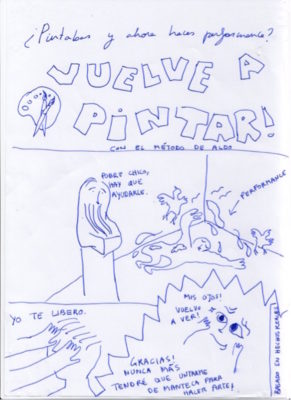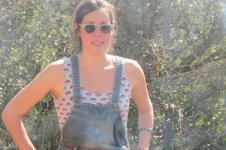Search
To search for an exact match, type the word or phrase you want in quotation marks.
A*DESK has been offering since 2002 contents about criticism and contemporary art. A*DESK has become consolidated thanks to all those who have believed in the project, all those who have followed us, debating, participating and collaborating. Many people have collaborated with A*DESK, and continue to do so. Their efforts, knowledge and belief in the project are what make it grow internationally. At A*DESK we have also generated work for over one hundred professionals in culture, from small collaborations with reviews and classes, to more prolonged and intense collaborations.
At A*DESK we believe in the need for free and universal access to culture and knowledge. We want to carry on being independent, remaining open to more ideas and opinions. If you believe in A*DESK, we need your backing to be able to continue. You can now participate in the project by supporting it. You can choose how much you want to contribute to the project.
You can decide how much you want to bring to the project.

Agrimiká is the Greek work used to describe wild, as opposed to domestic, animals. Agrimiká, Why look at animales? was the title for the montage of the Greek pavilion at the last Venice Biennale. The pavilion was structured like an onion in layers, so that the visitor first entered the actual pavilion, ruined, pompous and Neoclassical in style, to later enter a second interior space, within the pavilion. In the first the visitor walked amidst the remains from the previous edition of the Biennale, primarily dust, walls with holes, indescribable vestiges…Passing later through a second, fairly modest façade she entered into what was once a studio-shop for the curing of skins of wild animals. A studio-shop originally located in Volos, the capital of Magnesia, transferred in its entirety to Venice for the occasion. The agrimiká are the animals the pelts of which the previous owner of the workshop cured: boar, foxes, hares…animals that have resisted domestication, but which inhabit the margins of civilisation. These beasts are prized hunting spoils precisely for their “wild state” as it allows the hunter to proclaim triumph over the animal kingdom, representing the ancient tale of a man taking on nature in all its wildness (and sometimes winning). The trophy has the power of transferring to the “civilised” man the values attributed to the hunted animal: strength and a wildness of spirit. The agrimiká look at and talk to us, and through them, we talk about our condition tied naturally to culture.
This second space we entered into was also full of dust, but another type of dust, from another era and another place. It wasn’t the dust of a contemporary ruin like that at the entrance to the pavilion so much as it was the dust of the manual labour of one lone man, the dust of a place that no longer exists. The workshop represents a place for real as opposed to virtual exchange one dedicated to craftsmanship but also to encounters and leisurely chats over cups of coffee and swigs of Metaxa. Space to be defended in a globalised context, such as, for example, that of contemporary art.
We can travel around the planet and see the same exhibitions everywhere, or exhibitions that seem the same, with the same artists, or artists that seem similar. It could be due to the fact we always read with the same codes and don’t pay sufficient attention to particularities, alternatively, the exhibitions really are the same or very similar, not unlike those who travel from one place to another to visit them. Be it for the first, the codes, as much as for the latter, globalization, proposing specific activities in relation to an exhibition ought to make it possible to delve deeper into the particularities of the proposal. For example, the invitation to attend a workshop that complements an exhibition ought to mitigate this feeling. If the exhibition is a civilizing space, in that it cultivates but also in the sense we often assume an attitude of discipline and reverence regarding what surrounds us, whispering with our arms crossed behind our back. The workshop is the reverse, for a productive, proactive and propositional attitude is demanded of us as participants. We are asked to raise our voice and perhaps even use some tools.
It’s not a new question nor even an original one, but recalling the type of activities advertised as “workshops” that I have attended lately, they are more than a few, and if I add those that I have organised, well they are even more multiple. Workshop fever? The disenchantment of the viewer? Resistance to the digital world, to rapidity? The need to carry on training now that one’s student days are over? A need to share? The workshop as a format for the production of art? For sharing? For generating community? Workshopitis? Boredom?
Even though the idea of the “turn” always leads me to imagine someone breaking their neck with a forced twist of the neck, or of turning in circles in an overly frenetic form of lindy hop dancing, I reread some of the texts published in “Curating and the educational turn”, coordinated by Paul O’Neil, who by the way also came a few years ago to give a workshop at A*Desk. Without a doubt, this “workshopitis” has something to do with this “educational turn” described within curating, and the general interest of curators in pedagogical practices. Interest in understanding artistic practice as an extension of educational practices, and as such as a practice of mediation, or the need to relate them to each other. It’s about calling into question “access” to contemporary art, above all when dealing with non-object based practices. It is also about dismantling the labels of what have been named as collaborative practices, community generating practices, that however much they imply doing things with people, don’t always seek their participation in the same sense.
The announcement of a new turn in the contemporary art world indicates a change of focus, point to where the hegemonic practices will centre in times to come. In my mind, the turn perhaps invokes a forced gesture because the turns announced up until now are multiple (linguistic, social, cultural, spatial…) and the breakneck twists of the person who imagines them. This doesn’t detract from the relevance of curating practices involving educational practices nor the need for analysis, and one can squeeze in the indications we have detected of the proliferation of practical workshops within the framework of this turn. In this way we can situate the workshop in relation to artistic practices and not just to education. Artists and also curators give workshops, critics do writing workshops and reflect on the role of art criticism, performers give workshops on performance and there are even workshops about how to write a “good statement”. The workshop can come linked to an exhibition, as an extension or as a complement. Or not. It can also be an independent proposal.
The fact that workshops, in more or less abundance, are not a novelty leads me to think that it is something to do with the institutionalization of a practice that was already habitual in less hegemonic art spaces. If as Andrea Fraser said institutional critique no longer exists, it is instead the institutions themselves that adopt the critical function, (phew!) one could suggest that the broad range of workshops on offer has to do with a need to provide for this practice within the artistic institutions themselves. When all is said and done a workshop is a good idea, it is a space that is profitable for the artist (the workshop facilitator) and also the attendees, and also a way to justify the fees when artistic production dematerialises.
The list of workshops I have attended or recently organised that I recall while writing this text is: the workshop Dora García gave at MACBA at the beginning of February, where above all she shared materials that interested her, such as films and texts, of which I for one was totally unfamiliar. The workshop No Hacer given by Luz Broto in Estruch last spring, one which out of fear I didn’t attend (this case is interesting because the workshop was to stop doing for a few days, in whatever way each person wanted, I didn’t even go but have still thought a lot about it). Also at Estruch, I recall the workshop Daniel Moreno Roldán gave in mid-February this year that endeavoured to seek out the Secret name of things. The culmination consisted in trying to eat things of which we had not even the remotest idea of what they were. A workshop with Alejandra Riera that we organised last April with the Sala d’Art Jove, where she presented the raw material of her films, that was incredible. The workshop Jordi Mitjà did at La Puntual in January within the exhibition of Marcel Rubio. Where Jordi brought with him piles of little sugar sachets and we did what we wanted with them, intervening at length in the exhibition of Marcel. The radio workshop we did at La Capsa del Prat with Rubén Ramos and Eduard Mont de Palol that ended with a fantastic live broadcast and much laughter. And of course, the workshop we did with Aldo Urbano at La Puntual, the image of which heads this text.
If the museum is the place of production that follows the model of a factory, as Hito Steyerl proposed in her text “Is the museum a factory?”, workshops represent the model of production before industrialization, where the workshop was the only space for production. If the workshop is understood as a format of art practice (along the lines of performance or other collaborative practices) as much as a space that articulates artistic mediation (then we can also understand the work, in this case the workshop, as a mediator in itself) it ends up becoming a space of resistance to contemporary temporality. A switching off of Smartphones to give way to collective experience. A little like Agrimiká, without, however, becoming frozen in time or trapped in a pavilion (for the workshop of Volos, like the skins it sold, had to die to represent the attributes that culture granted it).

Caterina Almirall has only just been born into this world, but has lived in others, in similar parallel worlds, both liquid and solid. From each she has learnt something, and forgotten something else. Learning to unlearn. In all of these worlds she has been caught up in a web that interweaves everything, some call it ’art’…Entwining, unravelling, weaving and destroying this labyrinth has been her occupation in each one of these planets, and she fears that it will be the same in each of the ones to come.
"A desk is a dangerous place from which to watch the world" (John Le Carré)